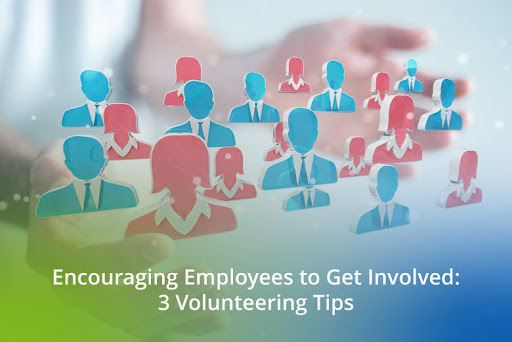Encouraging Employees to Get Involved: 3 Volunteering Tips

Despite their noble missions, nonprofits are often underfunded, and as a result, understaffed. As a solution to this, volunteers offer much-needed support through their time and effort to help nonprofits carry out the tasks to fulfill their missions.
One of the largest pools of potential volunteers comes from businesses and corporations, but the average employee volunteer participation rate is only 17%. To make your nonprofit’s volunteer opportunities attractive to corporate volunteers, you’ll need an established system for encouraging involvement.
That’s where this guide comes in—we’ll cover three tips for encouraging corporate employees to get involved with your nonprofit. Let’s get started!
1. Create a structured volunteer program.
Before you begin promoting your volunteer opportunities to corporate employees, or any volunteers at all, set a strong foundation. This means creating a structured and well-organized volunteering system for your nonprofit, allowing you to easily manage volunteers and provide opportunities they’re interested in.
As you establish your volunteer program, address the following elements in your plan:
- Recruitment strategy. Determine how you’ll recruit new volunteers, whether through social media advertising, email newsletters, or another method. You can also leverage your nonprofit CRM to connect with existing supporters or donors and ask if they’d be open to volunteering.
- Detailed volunteer role descriptions. Much like hiring a new staff member, volunteer recruitment involves providing detailed and accurate role descriptions for interested applicants. Include information about daily responsibilities, required skills, and volunteer hours.
- Training and orientation. After you’ve accepted volunteers, train them on your nonprofit’s systems and processes with a thorough orientation and onboarding process. By the end of it, volunteers should know more about your organization’s mission and be able to perform their duties confidently.
- Scheduling system. You’ll need some form of scheduling system to ensure that you always have the help you need to fulfill your nonprofit’s mission. When first starting, this can be as simple as a printed schedule, but as your volunteer base grows, you may want to invest in a dedicated scheduling tool.
When it comes to making your program more accessible for corporate employees, consider implementing a system for logging volunteer hours. Although this is not a critical aspect of your volunteer program, it can be helpful for corporate volunteers, as some of them receive benefits from their employers in exchange for their volunteer time.
For example, according to Getting Attention, some companies offer volunteer grants based on the number of hours an employee volunteers at an eligible nonprofit. Having a volunteer hours log makes it easier for employees to claim these grants on your organization’s behalf and prepare for post-award grant management.
2. Offer a variety of flexible volunteer opportunities.
After establishing the logistics of your volunteer program, you’re ready to target corporate employees with the right volunteer opportunities. After all, you’ll want to make it easy for any volunteer to engage with your nonprofit, so it’s crucial to offer flexible opportunities.
The first way you can be flexible with volunteering is to offer opportunities at different times of the day and with varying levels of commitment:
- Flexible volunteer time. As business employees generally work during weekdays, many may not be able to attend volunteering activities that take place during work hours. However, a lucky few who are offered volunteer time off by their employers may have more flexibility. Offer a variety of volunteer timeslots to accommodate any schedule.
- Flexible commitment level. Depending on the size and capacity of your nonprofit, you may need volunteers to occupy longer-term positions. However, this may not be suitable for volunteers who already have full-time jobs. Instead, offer volunteer opportunities with varying commitment levels, whether that’s attending a community cleanup for a few hours, generating new marketing materials every week, or becoming part of your nonprofit event planning team.
Let’s say that you’ve decided to take Phill the Box’s advice and host a clothing drive fundraiser, where you collect used clothing from community centers and then sell it to a recycling center or other organization. You might offer the following volunteer opportunities:
- Printing and posting event flyers around the neighborhood
- Setting up and tearing down a donation collection booth
- Collecting clothing donations
- Sorting clothing donations every week
- Managing social media marketing for the event
By offering a variety of flexible volunteer opportunities, you’ll be more likely to capture the interest of potential volunteers. Additionally, you might consider virtual volunteer opportunities for even more flexibility.
3. Reach out to local businesses.
An easy way to secure corporate employees as volunteers is to go straight to the source—local businesses. You can make volunteering at your nonprofit more enticing by forming partnerships with these businesses and focusing your outreach on the benefits that businesses will receive. Just take a look at these corporate volunteerism statistics:
- 70% of employees believe that their company’s commitment to volunteerism makes them feel more a part of the team.
- 54% of companies reported that having volunteering programs helped to achieve business objectives.
- In Fortune’s top 50 most admired companies, 96% have highly engaged employee volunteer programs.
- 55% of companies with volunteer programs experience better credibility with consumers.
A partnership with a business can lead to other benefits for your nonprofit aside from access to their employees for your volunteer program. For instance, a corporation purchasing new office equipment or furniture may be happy to donate their older equipment to your organization instead of simply throwing it away. Or, they may be open to more involved future partnerships, such as sponsorships or donation matching.
When you’re unfamiliar with reaching out to businesses and corporate employees for their help, you might be intimidated by the process. However, much like soliciting gifts from individual donors, you’re asking for a donation—but volunteers donate time and effort instead of money. Make the process easy for potential volunteers and be sure to steward them properly once they’ve given you their time.
Retaining skilled volunteers is not as easy as it seems. Download Golden to streamline your processes and connect with your volunteers better.
About the Author:
Donate This Recycle That has spent 30 years helping charities strategically collect and recycle clothing and household items from local communities. The organization keep tens of millions of pounds of usable items out of landfills every year by organizing clothing drive fundraisers for nonprofits.




